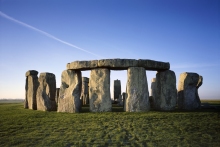The layout of Stonehenge matches the spacing of loud and quiet sounds created by acoustic interference, new theory claims

Two flutes playing the same continuous note set up a pattern of interference that apparently echoes the layout of Stonehenge. Photograph: Jason Hawkes/Getty
The Neolithic builders of Stonehenge were inspired by “auditory illusions” when they drew up blueprints for the ancient monument, a researcher claims.
The radical proposal follows a series of experiments by US scientistSteven Waller, who claims the positions of the standing stones match patterns in sound waves created by a pair of musical instruments.
Waller, an independent researcher in California, said the layout of the stones corresponded to the regular spacing of loud and quiet sounds created by acoustic interference when two instruments played the same note continuously.
In Neolithic times, the nature of sound waves – and their ability to reinforce and cancel each other out – would have been mysterious enough to verge on the magical, Waller said. Quiet patches created by acoustic interference could have led to the “auditory illusion” that invisible objects stood between a listener and the instruments being played, he added.
To investigate whether instruments could create such auditory illusions, Waller rigged two flutes to an air pump so they played the same note continuously. When he walked around them in a circle, the volume rose, fell and rose again as the sound waves interfered with each other. “What I found unexpected was how I experienced those regions of quiet. It felt like I was being sheltered from the sound. As if something was protecting me. It gave me a feeling of peace and quiet,” he said.
To follow up, Waller recruited volunteers, blindfolded them, and led them in a circle around the instruments. He then asked participants to sketch out the shape of any obstructions they thought lay between them and the flutes. Some drew circles of pillars, and one volunteer added lintels, a striking feature of the Stonehenge monument.
“If these people in the past were dancing in a circle around two pipers and were experiencing the loud and soft and loud and soft regions that happen when an interference pattern is set up, they would have felt there were these massive objects arranged in a ring. It would have been this completely baffling experience, and anything that was mysterious like that in the past was considered to be magic and supernatural.
“I think that was what motivated them to build the actual structure that matched this virtual impression. It was like a vision that they received from the other world. The design of Stonehenge matches this interference pattern auditory illusion,” said Waller, who described his research at a meeting of the American Association for the Advancement of Science in Vancouver.
“It’s not a complete structure now but there is a portion of the ring that still has the big megaliths arranged in the circle. If you have a sound source in the middle of Stonehenge, and you walk around the outside of the big stones, what you experience is alternating loud and soft, loud and soft, loud and soft as you alternately pass by the gaps and the stone, the gaps and the stone,” he added.
“So the stones of Stonehenge cast acoustic shadows that mimic an interference pattern.”
Waller argues that his findings are not mere coincidence and says local legend offers some support for his thesis. Some megaliths are known as pipers’ stones, while stories tell of walls of air forming an invisible tower, and two magical pipers that enticed maidens to dance in a circle before they turned to stone.
Stonehenge was built in several stages, with the lintelled stone circle constructed around 2,500 BC. The site was originally a burial ground, but may also have been a place for healing.
In 2009, Rupert Till, a music expert at Huddersfield University, used a full-scale replica of Stonehenge and computer analyses to show that repetitive drum beats and chanting would have resonated loudly between the standing stones.
Timothy Darvill, professor of archaeology at Bournemouth University, said that while sound played an important role in events at Stonehenge, the monument was probably not designed with acoustics in mind.
“The main structure is a replica in stone of what was normally built in wood,” he said. “They used the same techniques. The positioning of the main components is all about the construction of a framework, a building if you like, as the setting for ritual adventures that included the use of the bluestones brought over from Wales.”
Source: http://www.guardian.co.uk/science/2012/feb/16/stonehenge-based-magical-auditory-illusion?newsfeed=true
Sponsored by ‘The Stonehenge Tour Company’ http://www.StonehengeTours.com
Merlin says “Trippy stuff man………”
Merlin at Stonehenge
The Stonehenge Stone Circle Website
 around 5 miles over the downs, exploring some of the less visited monuments that together form the Stonehenge World Heritage Site. Bring your binoculars and keep an eye out for hares and winter birds too.
around 5 miles over the downs, exploring some of the less visited monuments that together form the Stonehenge World Heritage Site. Bring your binoculars and keep an eye out for hares and winter birds too.























